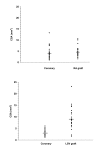Comparison of flow characteristics and vascular reactivity of radial artery and long saphenous vein grafts [NCT00139399]
- PMID: 16722590
- PMCID: PMC1440301
- DOI: 10.1186/1749-8090-1-4
Comparison of flow characteristics and vascular reactivity of radial artery and long saphenous vein grafts [NCT00139399]
Abstract
Background: The morphological and functional differences between arteries and veins may have implications on coronary artery bypass graft (CABG) survival. Although subjective differences have been observed between radial artery (RA) and long saphenous venous (LSV) grafts, these have not been quantified. This study assessed and compared the flow characteristics and in-vivo graft flow responses of RA and LSV aorto-coronary grafts.
Methods: Angiograms from 52 males taken 3.7 +/- 1.0 months after CABG surgery were analyzed using adjusted Thrombolysis in Myocardial Infarction (TIMI) frame count. Graft and target coronary artery dimensions were measured using quantitative coronary angiography. Estimated TIMI velocity (V(E)) and volume flow (F(E)) were then calculated. A further 7 patients underwent in-vivo graft flow responses assessments to adenosine, acetylcholine and isosorbide dinitrate (ISDN) using intravascular Doppler.
Results: The V(E) for RA grafts was significantly greater than LSV grafts (P = 0.002), however there was no difference in volume F(E) (P = 0.20). RA grafts showed positive endothelium-dependent and -independent vasodilatation, and LSV grafts showed no statistically significant response to adenosine and acetylcholine. There was no difference in flow velocity or volume responses. Seven RA grafts (11%) had compromised patency (4 (6%) > or = 50% stenosis in the proximal/distal anastomoses, and 3 (5%) diffuse narrowing). Thirty-seven (95%) LSV grafts achieved perfect patency and 2 (5%) were occluded.
Conclusion: The flow characteristics and flow responses of the RA graft suggest that it is a more physiological conduit than the LSV graft. The clinical relevance of the balance between imperfect patency versus the more physiological vascular function in the RA graft may be revealed by the 5-year angiographic follow-up of this trial.
Trial registration: ClinicalTrials.gov NCT00139399.
Figures


Comment in
-
The role of vessel wall physiology in predicting coronary bypass graft patency.J Cardiothorac Surg. 2006 Mar 3;1:5. doi: 10.1186/1749-8090-1-5. J Cardiothorac Surg. 2006. PMID: 16722578 Free PMC article.
Similar articles
-
Vascular reactivity and flow characteristics of radial artery and long saphenous vein coronary bypass grafts: a 5-year follow-up.Circulation. 2010 Aug 31;122(9):861-7. doi: 10.1161/CIRCULATIONAHA.109.887000. Epub 2010 Aug 16. Circulation. 2010. PMID: 20713903 Clinical Trial.
-
Angiographic outcomes of radial artery versus saphenous vein in coronary artery bypass graft surgery: a meta-analysis of randomized controlled trials.J Thorac Cardiovasc Surg. 2013 Aug;146(2):255-61. doi: 10.1016/j.jtcvs.2012.07.014. Epub 2012 Aug 4. J Thorac Cardiovasc Surg. 2013. PMID: 22871565 Review.
-
Patency of conduits in patients who received internal mammary artery, radial artery and saphenous vein grafts.BMC Cardiovasc Disord. 2020 Mar 24;20(1):148. doi: 10.1186/s12872-020-01433-0. BMC Cardiovasc Disord. 2020. PMID: 32204693 Free PMC article.
-
Radial artery and saphenous vein patency more than 5 years after coronary artery bypass surgery: results from RAPS (Radial Artery Patency Study).J Am Coll Cardiol. 2012 Jul 3;60(1):28-35. doi: 10.1016/j.jacc.2012.03.037. J Am Coll Cardiol. 2012. PMID: 22742399 Clinical Trial.
-
Radial artery bypass grafts have an increased occurrence of angiographically severe stenosis and occlusion compared with left internal mammary arteries and saphenous vein grafts.Circulation. 2004 May 4;109(17):2086-91. doi: 10.1161/01.CIR.0000127570.20508.5C. Circulation. 2004. PMID: 15123539 Review.
Cited by
-
Pharmacological stress cardiovascular magnetic resonance.Postgrad Med. 2011 May;123(3):162-70. doi: 10.3810/pgm.2011.05.2295. Postgrad Med. 2011. PMID: 21566427 Free PMC article. Review.
-
Diagnostic and Management Strategies in Patients with Late Recurrent Angina after Coronary Artery Bypass Grafting.Curr Cardiol Rep. 2022 Oct;24(10):1309-1325. doi: 10.1007/s11886-022-01746-w. Epub 2022 Aug 4. Curr Cardiol Rep. 2022. PMID: 35925511 Free PMC article. Review.
-
Measurement of endothelial function and its clinical utility for cardiovascular risk.Vasc Health Risk Manag. 2008;4(3):647-52. doi: 10.2147/vhrm.s2769. Vasc Health Risk Manag. 2008. PMID: 18827914 Free PMC article. Review.
-
The cardiovascular system and the biochemistry of grafts used in heart surgery.Springerplus. 2013 Nov 16;2(1):612. doi: 10.1186/2193-1801-2-612. Springerplus. 2013. PMID: 24324924 Free PMC article. Review.
-
Radial artery graft vs. saphenous vein graft for coronary artery bypass surgery : which conduit offers better efficacy?Herz. 2014 Jun;39(4):458-65. doi: 10.1007/s00059-013-3848-5. Epub 2013 Jun 21. Herz. 2014. PMID: 23784362 Review.
References
-
- Gaudino M, Alessandrini F, Pragliola C, Cellini C, Glieca F, Luciani N, Girola F, Possati G. Effect of target artery location and severity of stenosis on mid-term patency of aorta-anastomosed vs. internal thoracic artery-anastomosed radial artery grafts. Eur J Cardiothorac Surg. 2004;25:424–428. doi: 10.1016/j.ejcts.2003.11.027. - DOI - PubMed
-
- Khot UN, Friedman DT, Pettersson G, Smedira NG, Li J, Ellis SG. Radial artery bypass grafts have an increased occurrence of angiographically severe stenosis and occlusion compared with left internal mammary arteries and saphenous vein grafts. Circulation. 2004;109:2086–2091. doi: 10.1161/01.CIR.0000127570.20508.5C. - DOI - PubMed

